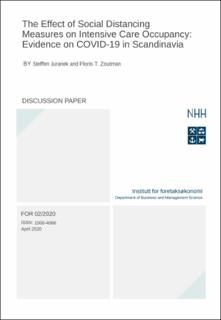The Effect of Social Distancing Measures on Intensive Care Occupancy: Evidence on COVID-19 in Scandinavia
| dc.contributor.author | Juranek, Steffen | |
| dc.contributor.author | Zoutman, Floris T. | |
| dc.date.accessioned | 2020-04-29T11:22:58Z | |
| dc.date.available | 2020-04-29T11:22:58Z | |
| dc.date.issued | 2020-04-29 | |
| dc.identifier.issn | 1500-4066 | |
| dc.identifier.uri | https://hdl.handle.net/11250/2652920 | |
| dc.description.abstract | Understanding the effectiveness of social distancing on the spread of COVID-19 is crucial to justify economically costly social distancing measures. We present a case study focusing on the three Scandinavian countries. Whereas Denmark and Norway imposed relatively strict measures, Sweden follows an extraordinarily lenient approach. We use an event-study approach in which Sweden serves as a counterfactual to Denmark/Norway to estimate the measures’ effectiveness. We estimate that in the counterfactual in which Denmark/Norway implemented Sweden’s more lenient measures the number of hospitalizations would have peaked between around 15-20 days later. The peak number of hospitalizations in Denmark (Norway) would have been 133 (231) percent higher, and the peak number of ICU patients would have increased by 107 (140) percent. | en_US |
| dc.language.iso | eng | en_US |
| dc.publisher | FOR | en_US |
| dc.relation.ispartofseries | Discussion paper;2/20 | |
| dc.subject | COVID-19 | en_US |
| dc.subject | Social Distancing | en_US |
| dc.subject | Intensive Care | en_US |
| dc.subject | Case Study | en_US |
| dc.title | The Effect of Social Distancing Measures on Intensive Care Occupancy: Evidence on COVID-19 in Scandinavia | en_US |
| dc.type | Working paper | en_US |
| dc.source.pagenumber | 13 | en_US |
Tilhørende fil(er)
Denne innførselen finnes i følgende samling(er)
-
Discussion papers (FOR) [564]
